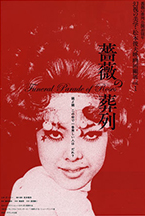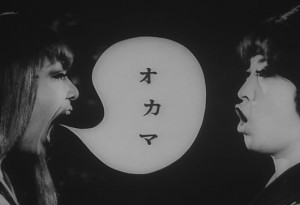FUNERAL PARADE OF ROSES

(Toshio Matsumoto‘s subversive 1969 film Funeral Parade of Roses is back in theaters for a limited time. Catch it while you can!)
Funeral Parade of Roses ends with a quote: “The spirit of an individual reaches its own absolute through incessant negation.” It could be referring to the “no!” with which a toddler first asserts its separate identity; it could be the Buddhist negation of the ego, but most likely it’s about cultural renewal: Funeral Parade of Roses, with its fun and free gender fluidity, sexuality, drugs and rock’n’roll must have been a shocking fuck-you to Japanese social mores when it was released.
It was a time long before the distinction between gay and trans was in the public consciousness — the same year as the Stonewall riots. Funeral Parade of Roses is on one level a document of queer identity exploding from some of its many closets, still suffused with fetishized tragedy and subservience to traditionally male figures. But its intentions are faceted and postmodern —the Oedipus Rex-derived narrative surfaces briefly and somewhat tangentially during most of the film’s runtime, only taking over in the bloody finale. Matsumoto darts off on endless asides and detours, constantly break through the film’s surface and structure. He’s first and foremost an experimental filmmaker, and the film is designed as a maximalist collage. He borrows liberally from Godard, with a breathless desire to show and tell: jump-cuts, rapid-fire montages of pop-culture imagery, philosophical quotes popping up in intertitles, behind-the-scenes footage.
Lead actor Pîtâ, who was only 16 when the film was shot, has been compared to Edie Sedgwick, and he has a similar charisma but a more determined and aggressive presence, strutting with girl-power around Tokyo in a mini-dress with two girlfriends, peeing at public urinals, licking soft-serve ice-cream cones, getting into a catfight with real girls. Osamu Ogasawara as the doomed rival, aging out of her position as the top girl at the Genet club (despite only looking 25ish), gives a wonderfully nuanced, emotional performance, and the shot of her in death, surrounded by white roses (“she loved roses—and they had to be artificial ones”), presages Candy Darling’s famous death bed photos from several years later.
A parenthetical discussion of the masks we wear, the masks beneath the masks, and the masks we don’t realize are there juxtaposes nicely with the milieu of the film, in which gender identity is diffracted and 60s cool is a costume itself: the guests at a sex and drugs party, for example, are dressed and styled in a way that mimics the Beatles poster above them; one character calls himself “Guevara” and wears a fake beard. The film also borrows from Warhol and the Factory esthetic, but it has an un-Warholian meticulousness of craft: the black and white cinematography is crisp and intentional, with elegant pans (often into mirrors), dolly moves and precise exposure. The grainy texture that feels casual in Warhol films here is a deliberate aesthetic choice.

The film takes a brilliant approach to furthering a socio-political agenda: Matsumoto stages a storyline that could be considered stereotypical—it’s main story is campy and reductive, perpetuating the idea of gay or trans characters as jealous, hysterical, conniving, mercenary and desperate, competing with and destroying one another. But at the same time it’s a reclaiming of these archetypes, a blithe expression of the kind of camp sensibility that largely defined pre-Stonewall gay culture. And crucially the film digs deeper to reveal the vulnerable, relatable, three-dimensional gay people behind the theatrics. In their interviews, the “gay boys” are matter-of-fact and unassuming about who they are and how they relate to their characters; proto-gay pride is expressed with quiet clarity. They don’t seem to realize that by coming out on camera they’re pioneers of gay liberation.
The central image of the film is the event referenced in the title: a procession of men parading through a busy city street wearing white armbands and surgical masks, holding up their white-gloved left hands with the fervor of a religious cult and holding white boxes loosely wrapped in white mesh fabric. One of them wears a gas mask. This scene is a departure from the poppy/campy tone of most of the film and signals a seriousness of intent. Perhaps it suggests the film’s revolutionary motives—its ambition to fundamentally transform Japanese culture with the spirit of 60s youth culture and idealism. But there are layers that can’t be explained away quite so simply—what gifts might be inside the packages, whether they’re benign or meant to destroy, remains a mystery.
– Paul Sbrizzi











